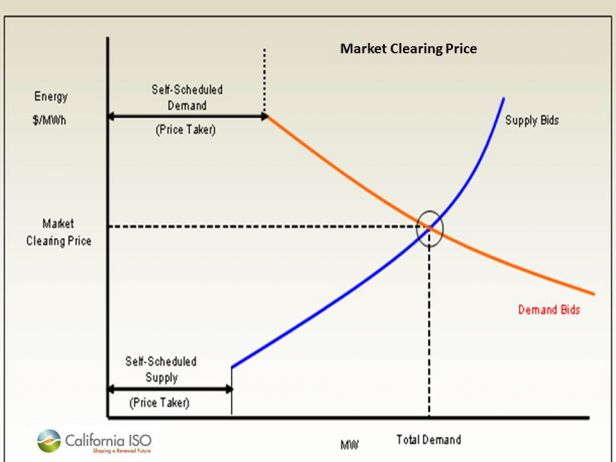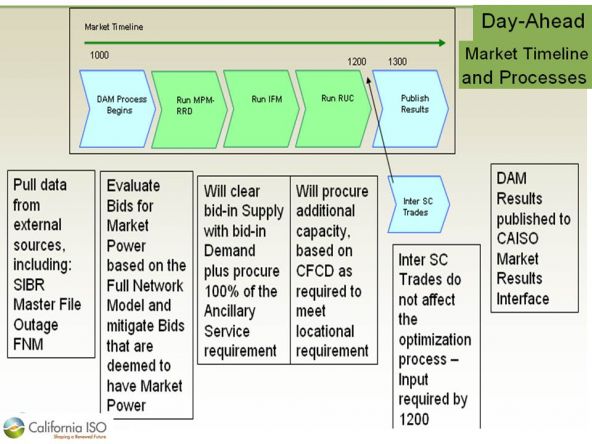Thirty thousand daily energy transactions between 140-plus electricity buyers and sellers: That’s the $8 billion, 4,500-active-node energy market the California Independent System Operator Corporation (ISO) manages.
The same ISO keeps power flowing reliably from 671 power plants (1,400-plus power plant units) along 25,865 transmission line circuit miles to 30 million electricity consumers, and maintains emergency reserves for any eventuality while it matches a supply of almost 58,000 megawatts of installed electricity capacity with demand that has peaked at 50,270 megawatts.
For those services from the ISO, a typical California electricity consumer pays less than a dollar.
The ISO has sole responsibility for managing California’s wholesale energy market and keeping most of the state’s lights on, under the direct jurisdiction of the Federal Energy Regulatory Commission (FERC).
How will the ISO include 33 percent renewables by 2020? The same way it matches demand and supply today.
Power purchase agreements (PPAs) between utilities, sometimes referred to as Load Serving Entities (LSEs), and energy generators assure that “well over 90 percent of the energy we use and consume in California is already under contract and supplied to us,” ISO spokesperson Steven Greenlee explained.

It all starts in a day-ahead market that opens seven days in advance of the targeted trading day and closes at 10 AM on the day before the energy will be used. Through three progressive stages (Market Power Mitigation, Integrated Forward Market, Residual Unit Commitment), the market receives buy and sell bids, guarantees supply will meet demand, clears the price and settles the transactions.
“We have all of the tools here, including market power mitigation and bid price screens,” Greenlee explained. Everything goes through the ISO Market Results Interface (CMRI) and “in many cases, it’s automatic.”
Real-time prices, demand forecasts, transmission status, and other market data are provided on the California ISO Open Access Same-Time Information System (OASIS) site for market participants and the public.
“The utilities are typically the buyers. The generators are the sellers,” Greenlee said. “It’s similar to other commodities markets with single clearing prices. Whenever that market is cleared, the generation is scheduled and it’s delivered. And since it’s electricity, that’s very nearly instantaneous.”
In procuring supply to meet demand, the ISO must follow a pre-established California Public Utilities Commission (CPUC) loading order and guarantee the availability of adequate ancillary services to meet the unexpected.
The CPUC-mandated loading order begins with cost-effective energy efficiency and demand response measures. Renewables like wind and solar power plants and distributed generation like rooftop solar and combined heat and power come next. Only after purchasing those sources can the ISO turn to fossil-fired generation to meet its demand needs.
Consumers are protected by the computerized selection of a market clearing price for all electricity transactions. It is the lowest price that would provide enough electricity, Greenlee explained.
Each generator bids to sell at a range of megawatts for a specific price; each LSE bids a volume range for a price they are willing to pay. The market clearing price is where the supply and demand curves cross. “In other words, the lowest cost bids are matched to buyers until all demand bids are covered,” Greenlee said.
The last generator bid accepted sets the clearing price. “All sellers get it and all buyers pay it, as in typical commodity markets,” Greenlee summarized. “It goes back to the very simplistic but telling fact that we match supply with demand. That’s what we do.”

These processes are completed and published to CMRI at 1 p.m. the day before the targeted trading day.
Just before that, trading activity, firewalled from the ISO’s supply-demand operations, must close. Traders “are market participants who don’t engage in the physical trading of electricity but they do participate in the virtual bidding, which we call convergence bidding,” Greenlee said. “That is mainly financial instruments. It doesn’t involve the actual trading of physical electricity.”
The real-time market opens when the day-ahead process is complete and closes 65 minutes ahead of each operating hour. Day-ahead resources provide 98 percent of the ISO's energy needs. The real-time market is incremental, directed at changes to load from updated demand forecasts, and settled separately.
“Our goal is to run an efficient market so that the day-ahead prices and the real-time prices are as close to each other as possible,” Greenlee explained.
Through a series of five real-time market processes, last-minute energy needs can be procured, priced and dispatched to balance supply with demand. Ancillary services that stabilize the grid, balance voltage fluctuations and respond to grid disturbances, procured in the day-ahead market, are available if needed at this point.
“Again,” Greenlee concluded, “most of this power is already contracted for in the first place. Then it’s a matter of, by market rules” and according to “the laws of market dynamics and supply and demand,” establishing the market clearing price that is most efficient for California’s ratepayers.
Many levels of safeguards, Greenlee stressed, are built into the ISO’s market. “It is the CPUC’s loading order that tells us what we have to load and how we load it.” Tariffs are “vetted through a stakeholder process,” he added, and “our stakeholders include the public at large and their advocacy groups.”
Finally, he said, the ISO is regulated by the FERC. “They say, ‘OK, you must look at the most efficient resources.’ That’s our focus 24/7.”





